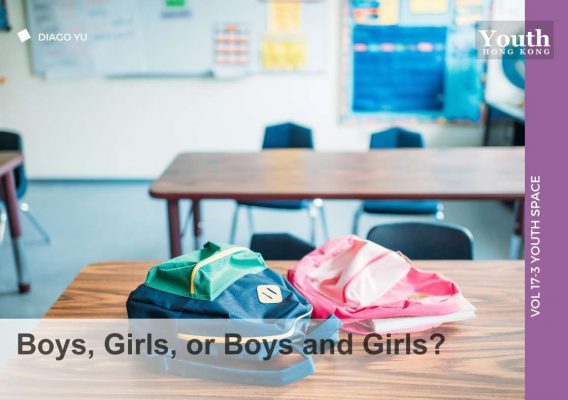by Diago Yu
Is growing up in mixed schools a recipe for distraction or the best training ground for equality, respect and real-world relationships?
I have been studying in co-educational schools for 12 years and believe that this has shaped my personality and growth. I’ve come to believe that mixed-gender education offers significant benefits that outweigh its drawbacks, given my healthy school life, genuine friendships, and the mere enjoyment of being at school.
The most cogent reason in favour of mixed schools is their potential to promote gender equality through daily communication. Studying in the same schools, boys and girls work together, collaborate on assignments and navigate challenges as teammates. These experiences teach them to communicate, respect each other, and treat one another with kindness and good manners.
Working with both boys and girls has made me a better communicator, enhancing my exposure to those of various working styles and characters. The diversity has really motivated me to understand what individuality means and how it should be respected. Looking forward, I feel certain that I can communicate with everyone more empathetically.
I have also become more aware of behaviour and how the social sensitivity often seen in girls complements the assertiveness commonly found in boys. Over time, this balance can help dismantle harmful assumptions about gender roles and encourage healthier, more respectful dynamics.
Discipline, too, can improve in a co-ed environment. Students may want to uphold a positive image in front of the opposite sex. Trying to demonstrate their mannerism and attractiveness, they demonstrate attentiveness in class and a focused learning attitude. Personally, I pay much more attention to my behaviour and appearance around girls so as to present a better image of myself. Apart from leading to my improved hygiene and courteous actions, this has also encouraged other boys I know to be more polite and respectful to others.
A more diverse classroom environment creates a more harmonious learning environment and naturally discourages the kind of peer-group behaviour—such as aggression or groupthink—that sometimes flourishes in all-boys or all-girls settings. A social experiment in the US revealed that when ten boys were left together in a house without supervision for a week, they physically fought for power over one another and wreaked havoc.
That said, co-educational systems are not without drawbacks. The most fundamental observation is that students may share a less tight-knit bond with their peers. For instance, many boys’ schools highlight the idea of “brotherhood” with lifelong memories and unforgettable bonds.
In mixed schools, personal growth may be adversely affected when same-sex friendships are less prominent, with a lack of close brotherhood where hard work and challenges are not as deeply shared.
Similarly, another common concern of mixed schools is the higher possibility of romantic relationships, which could distract students from their studies or lead to emotional complications. Overall, students are more likely to date in mixed schools, except for the rare case of homosexuality, mostly due to regular interactions between boys and girls.
While these concerns are valid, they don’t necessarily apply to all students. Not everyone forms close same-gender friendships in single-sex schools, and not all dating relationships in co-ed settings are problematic. In fact, some students report that having a partner at school can be motivating—providing emotional support and encouraging goal-setting. When I have a new crush, I often work harder in my ECAs and boost my grades, thus demonstrating that love is a form of motivation for me. It inspires me to reach my full potential and continuously improve.
There is also evidence that boys in single-sex schools, on average, perform better academically across a range of subjects, ranging from sciences to humanities. For students going through the often-confusing journey of adolescence, a close-knit, same-gender support system can provide comfort and stability.
A Hong Kong University research has found that students from single-sex schools are more gender-salient and more anxious in mixed-gender situations. From my own experience, I also found that respectful co-ed interactions have helped me grow as a communicator and a more open-minded individual. Meanwhile, dating in school seems far less common than people assume, and its effects vary widely depending on the individuals involved.
Ultimately, while same-sex schooling may offer certain advantages for specific students, the broader societal benefits of co-education—better gender understanding, improved discipline, and more inclusive learning environments—make a stronger case. Mixed schools reflect the world students will eventually enter: one that requires them to work, live, and build relationships across genders.
As we look ahead, I hope Hong Kong’s education system will embrace a more integrated approach. Mixed schools aren’t a perfect solution, but they’re a step toward a more equal and socially aware generation. ■
Diago is a student from St Paul’s Co-educational College. With a passion for writing, he hopes to make a difference with pen and paper. When he’s not writing, you’ll find him doomscrolling, volunteering, or joining Model UN conferences.



